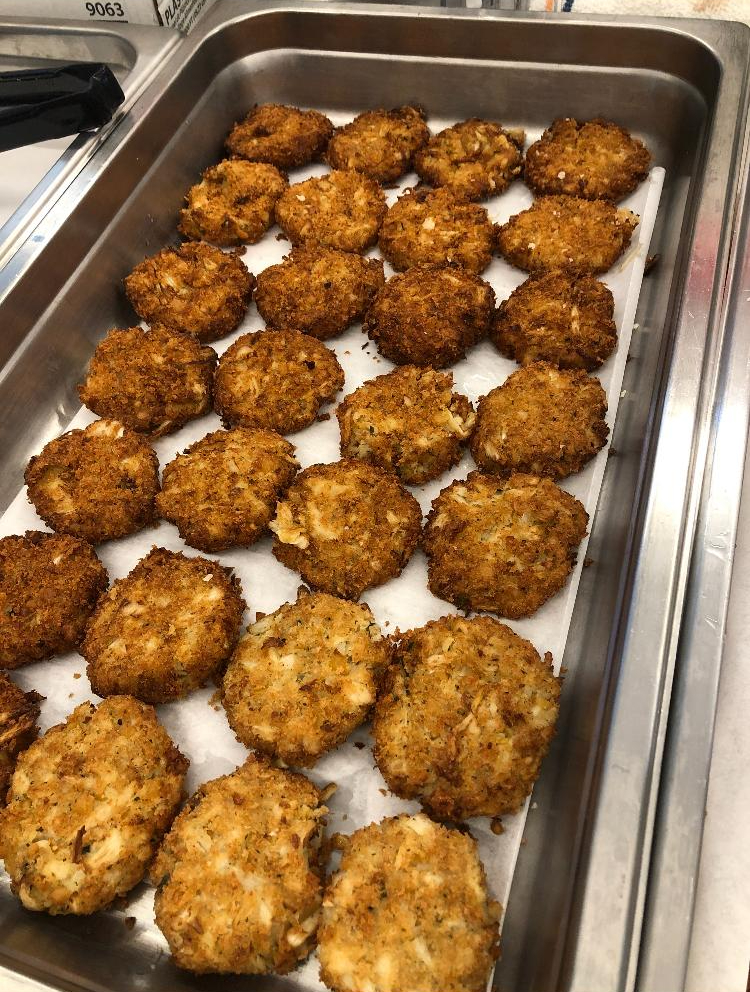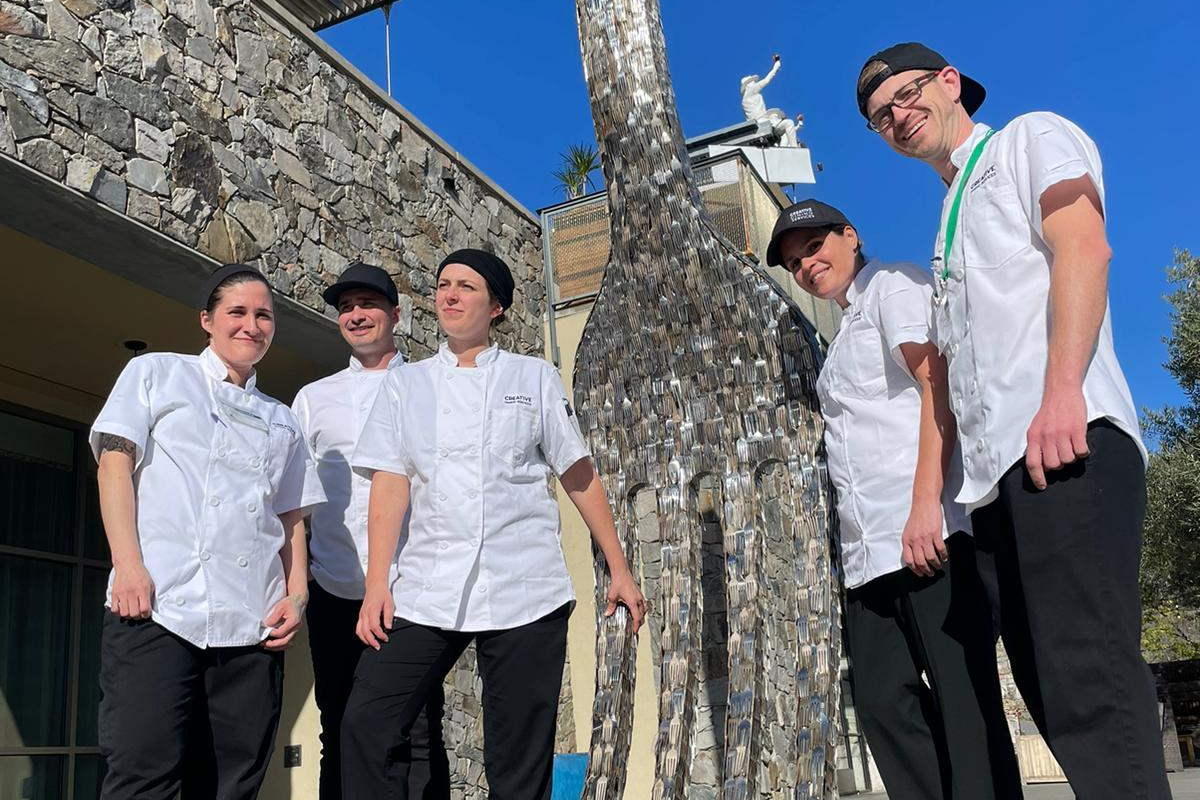What do barbecue, fried fish, and black-eyed peas have in common? All these common cooking techniques or ingredients originally came to North America from Africa.
This culinary impact, as well as other ingredients and preparation methods, took center stage at Worlds of Flavor 2022. Hosted each year at the Culinary Institute of America in Napa, California, the theme was “Africa and the World: Reclaiming the Past, Crafting the Future.”
Seven Creative Dining Services chefs attended the event this year to learn from—and work firsthand with—featured guest chefs from around the world. Here are some of their highlights from the event.

History’s Impact on Culinary Trends
One of the most impactful culinary lessons our chefs learned at Worlds of Flavor this year happened without stepping foot in a kitchen. The introductory session featured a discussion about the Atlantic slave trade and how it spread common African foods to North America, South America, and the Caribbean. The session emphasized how different departure and arrival locations impacted which foods made their way to western countries.
“The intro session was really emotional,” said Nathaniel Malone, a Creative Dining chef. “I was blown away by the number of slave ships that went to Cuba, Brazil, and the Caribbean starting in the 1400s.”
Creative Dining chef Marie Gibson found the experience incredibly educational as well. Like many people, she hadn’t realized just how many commonly-eaten foods in the US came over from Africa during that time. Foods we often take for granted like watermelon, yams, okra, and even some species of peppers arrived in North America due to the slave trade. Even the kola nut, supposedly an ingredient in the original Coca Cola recipe, came over from Africa’s tropical rainforests.
Familiar & New Flavors of Africa
Creative Dining chefs got to work hands-on with the event’s featured chefs. They helped them prepare dishes and components within their areas of expertise. They not only experienced “American” foods with African roots, but also several ingredients and cooking styles used in Africa today.
Mauritanian Cuisine from Northwest Africa
Chef Diane Tandia, the owner of Berber Street Food in NYC, is originally from Mauritania in northwest Africa. After attending a French culinary school, she developed her own style of cooking by combining her Mauritanian roots, French techniques, and a bit of Asian-inspired flair to create truly unique dishes.
She introduced our chefs to two unique ingredients from the same animal: camel meat and hump fat, which are primarily eaten in the Middle East and in Northeast Africa.
Contrary to the popular myth that camels store water in their hump, it’s actually the area of their body where they store nutrient-dense fat. Our chefs saw this used as a replacement fat in cooking in place of other solid fats like coconut oil, lard, or tallow.
Considering camel humps are entirely made of fat, it may surprise some to learn that camel meat is one of the leanest meats. Camel meat packs a serious nutritional punch, similar to other red meats without the higher fat content.

Traditional Gullah Geechee Cooking
Our chefs had the opportunity to work with two Gullah Geechee-specializing chefs: Benjamin “BJ” Dennis IV and Matthew Raiford. According to the Gullah Geechee Cultural Heritage Corridor Commission, “The Gullah Geechee people are descendants of Africans who were enslaved on the rice, indigo, and Sea Island cotton plantations of the lower Atlantic coast.” The isolated nature of island and coastal plantations led to a distinct culture, which extends to their unique cuisine.
The two Gullah Geechee chefs put different spins on their cuisine. Chef BJ focused heavily on ingredients traditionally used in lower-income households. His feature dish—oxtail stew—had a richer flavor and silkier texture compared to a more “traditional” beef stew.
Chef Matthew is a descendant of the Gullah Geechee in coastal Georgia. He taught chefs about “lowcountry Georgia cooking,” which is a subset of southern soul food. Our chefs helped him put together collard and rice dumplings with mamba sauce, lime-roasted okra, and shrimp with grits. For a unique twist, the dish used furikake (a Japanese dry condiment), sea island red peas, and red palm oil.

Vegan African Soul Food
When people think of “soul food,” often they think of dishes like shrimp ‘n’ grits, fried catfish, and fried chicken. But chefs continue opening up the world of southern soul food to vegan and vegetarian diners. Two Creative Dining chefs, Danielle and Marie, worked with Chef Shenarri “Greens” Freeman of Greedi Vegan in NYC, making delicious vegan twists on traditional African American soul food such as crab cakes, hush puppies, slaws, and potato salad.
“I was amazed by the clever use of Hearts of Palm as a substitute for crab as the textures are so similar,” Creative Dining chef Danielle Hunter remarked. “The addition of Granulated Kelp combined with the acid of the Palm created a stunning flavor that is very similar to a traditional Crab Cake.”
Working with new vegan-friendly ingredients provided our chefs with ample inspiration to bring back to their accounts for their plant-forward and internationally-inspired dining stations.
Reclaiming a Robust Connection to Cuisine
Worlds of Flavor covered another topic dear to many: the ability to reclaim culture through culinary exploration. For a variety of reasons—including colonialism, slavery, the modern food system, and decolonization processes—many groups of people have lost important aspects of their food culture and access to ingredients. We’ve talked before about the importance of authenticity when cooking cultural foods. The same rule applies when honoring the history of dishes, their point of origin, and their cultural significance.
Part of honoring cultural food is taking an open and honest look at its roots and the impact of those roots. We’re already excited to see how our chefs integrate the flavors, recipes, and culinary techniques they’ve learned into their accounts.
We hope you’ve found these event takeaways as insightful as our chefs did! To learn more about Worlds of Flavor, you can visit their website at www.worldsofflavor.com. For more information on how you can begin implementing this culturally-focused mindset for your own dining halls, reach out to us.




